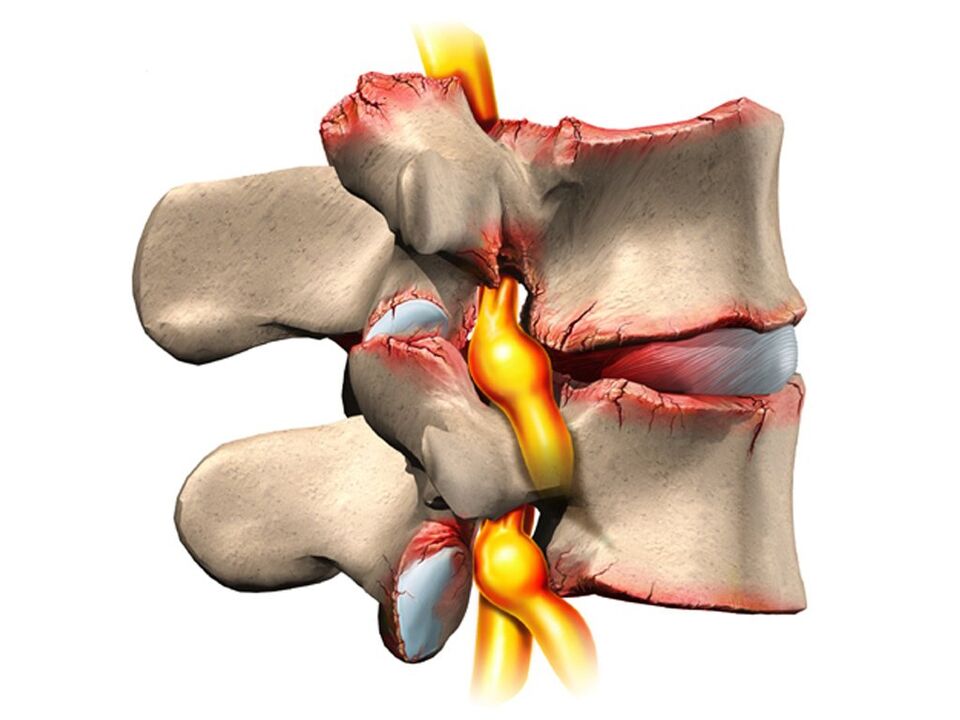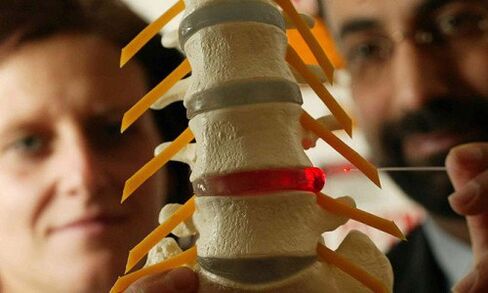
The term osteochondrosis itself is derived from two words: bone-bone and cartilage-cartilage. Simply put, it is cartilage ossification. Although this explanation is fundamentally wrong. Some people's delusions go further. They believe that osteochondrosis is the accumulation of salt in the joints. In addition, it is speculated that edible salt is edible salt in large quantities.
Onset
In reality, everything has happened something different. And it's harder. And table salt, if it plays any role in the occurrence of osteochondrosis, it is very indirect. Osteochondrosis is based on the degeneration and degeneration of articular cartilage. This is not an independent disease, but a pathological process that can be noticed almost anywhere with connective cartilage tissue.
Nevertheless, osteochondrosis affects the spine in most cases. why is that? The fact is that there is a kind of cushion between the vertebrae-intervertebral (intervertebral). The physiological role of these intervertebral discs is to cushion and protect the vertebral body from premature wear caused by mechanical stress. The intervertebral disc consists of an internal liquid nucleus, surrounded by an annulus fibrosis and an upper and lower endplates.
The intervertebral disc is subjected to tremendous mechanical stress, causing permanent damage to its structure at the cellular level. In humans, these processes are too obvious-this is the price we pay for walking upright. In order to prevent the disk from being completely "erased", it must be regenerated continuously, that is, rebuild itself. The balance of the injury-regeneration process determines the normal structure of the intervertebral disc. Another strange detail is that the blood and nutrient supply to the intervertebral disc is not carried out through the overgrowth of blood vessels in childhood, but through the bone tissue of the vertebral body. Again, the ability to pay moves two limbs instead of four.
Therefore, in terms of anatomy and physiology, the intervertebral disc is easily injured. Any negative process in the body can lead to an imbalance in the damage-regeneration balance and lead to malnutrition and degeneration of the intervertebral disc. An optical disc with a defective structure can no longer withstand proper mechanical stress. Under excessive pressure from the overlying vertebrae, the intervertebral discs shift in different directions, usually to the sides and back. This process is called herniated disc.
The bone tissues of the vertebrae that have lost their cartilage lining are also subject to mechanical abrasion. Due to the continuous trauma to the anterior surface of the vertebral body, pathological bone growth-osteophytes was formed. Spondylopathy develops. Due to the degeneration and displacement of the intervertebral disc, the intervertebral space shrinks and the spinal canal becomes narrower, and the spinal nerve roots in the so-called intervertebral foramina are violated.
reason
The causes or causes of osteochondrosis are diverse. They can be local, that is, due to the pathology of the spine itself, or they can be general diseases at the body level. Any pathology that leads to structural destruction of the spine or metabolic disorders can be considered as the cause of osteochondrosis. In this regard, there are:
- Changes in the structure of the spine (scoliosis, pathological lordosis or kyphotic deformity).
- Other defects of the musculoskeletal system include flat feet, narrow shoulder straps, and abnormal pelvic structure.
- Spine injury.
- Weak immunity.
- Metabolic disorders-osteoporosis, obesity, diabetes, thyroid disease.
- Cardiovascular diseases-atherosclerosis, high blood pressure.
- Digestive system diseases lead to insufficient absorption of nutrients in the gastrointestinal tract.
- Genetic.
It should be noted that the above pathological conditions do not necessarily cause osteochondrosis. This requires constant exposure to certain predisposing factors-hypothermia, malnutrition, a sedentary lifestyle, or, conversely, excessive physical exertion.
symptom
Osteochondrosis itself is an asymptomatic process. And, at the same time, the signs of intervertebral disc degeneration are diverse. how so? In fact, the clinical manifestations of osteochondrosis are based on its complications-intervertebral disc herniation, spondylosis, sciatica, spinal stenosis.
In addition, according to the main location of the process in the cervical, thoracic, or lumbosacral spine, clinical manifestations vary greatly. The last part is most often affected because it is the most physical activity undertaken by the lower back. Signs of lumbosacral osteochondrosis:
- Pain (low back pain, low back pain, sciatica).
- Limited movement of the lower back and lower limbs (intermittent claudication).
- Here, paraesthesia types of sensitivity disorders-numbness, burning, crawling.
- Pathological tension of the psoas muscle.
- Without treatment, the pelvic organs are dysfunctional.
Compared with the lumbosacral region, the frequency of observation of cervical osteochondrosis is slightly lower. However, this pathology is also very common. In addition to the typical signs of pain (neck pain), upper limb sensitivity and decreased movement, cervical osteochondrosis due to impaired blood supply to the brain has its own characteristics. These characteristics are manifested in:
- Insomnia.
- Headache, dizziness.
- Periodic nausea.
- The whole body is weak and fatigued easily.
- Fluctuations in blood pressure.
- Occasionally toothache.
- Behavioral reactions such as tearing and irritability.
The chest area with osteochondrosis is relatively unaffected. In this case, the patient is someone who is forced to sit in an uncomfortable fixed position due to occupation-student, schoolchild, programmer, office worker. In this case, the symptoms of osteochondrosis are as follows:
- Chest pain and paresthesias.
- Difficulty breathing.
- The feeling of heartbeat.
- Limitation of thoracic spine movement.

diagnosis
In summary, osteochondrosis is a chameleon disease. Because of the similar physical signs, it is easily confused with cerebrovascular accidents, hypertension, myocardial infarction, angina pectoris, neurosis, etc. This is why, in order to make a correct diagnosis, a comprehensive and complex diagnosis is necessary to correctly determine the symptoms and treatment of osteochondrosis.
In addition to traditional inquiries and clarification of patient complaints, this diagnosis should also include medical examinations and special research methods. These methods include spinal X-rays and visceral ultrasound. Recently, computers and magnetic resonance imaging have been successfully used to diagnose osteochondrosis.
treatment
Treatment strategies for osteochondrosis include the use of:
- drug.
- massage.
- Physical therapy procedures.
- Physical therapy (exercise therapy).
- Manipulative therapy.
- acupuncture.
Drugs used to treat osteochondrosis are mainly aimed at relieving pain and eliminating the inflammatory process of nerve roots. In various combinations, these drugs are widely used in the treatment of osteochondrosis in the form of ointments, injections, and tablets. It should not be forgotten that these drugs have a negative effect on the liver, stomach and intestines. In this way, they can aggravate the metabolic disorder of osteochondrosis. They used a local anesthetic to relieve the pain of the blockade. It is true that the effect of these funds is short-lived and will never affect the entire course of osteochondrosis.
With the help of drugs such as chondroprotective agents, immune stimulants and vitamins containing minerals, it can improve the local and body-level metabolic processes. Chondrprotectants are used in tablets, ointments and ampoules. In fortifiers, vitamin C and B groups are used together with minerals. In this regard, calcium preparations are most preferred. In fact, contrary to some false claims, the basis of osteochondrosis is not an excess of calcium, but only a lack of calcium.
After successfully relieving the deterioration of the condition, physical therapy procedures, massage and exercise therapy will be displayed. As physical procedures, calcium electrophoresis, hydrocortisone ultrasonic electrophoresis, amplipulse, and paraffin therapy are used. All these measures aim to eliminate pain and inflammation of nerve roots, ligaments and muscles. Perform osteochondrosis massage according to generally accepted methods. Select the massage area according to the location of osteochondrosis. The expansion of the range of motion is achieved with the help of exercise therapy. In the beginning, during the deterioration phase, there is almost no dynamic load. The patient is always in the best posture. At this time, it is best to wear a fixation device-waist girdle, Shants neck brace. As the deterioration subsided, the amount and duration of exercise during exercise therapy increased.
Recently, in the treatment of osteochondrosis, non-traditional treatment methods have been accepted-acupuncture, manual therapy, and osteopathy. Acupuncture affects specific biologically active spots located on the spine, auricles, hands and feet. Through manual treatment, the normal position of the vertebrae and intervertebral discs is restored by expert hand movements. During osteopathy, the structural integrity of the musculoskeletal system is ensured by specific techniques. In the absence of conservative measures to treat osteochondrosis, persistent pain, and complications, surgery is required. The pathologically displaced disc was removed. Currently, for this purpose, a microdiscectomy-endoscopic removal of displaced discs is performed.















































